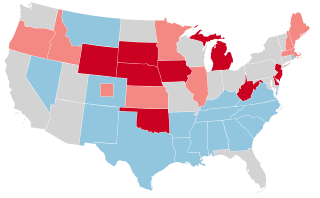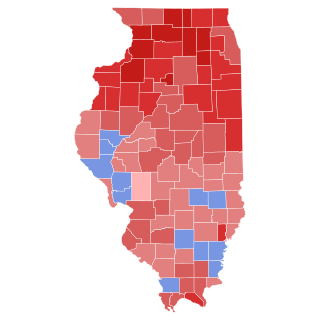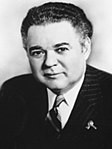
The 1978 United States Senate elections were held on November 7, in the middle of Democratic President Jimmy Carter's term. The 33 seats of Class 2 were contested in regular elections. Special elections were also held to fill vacancies.

The 1970 United States Senate elections was an election for the United States Senate. It took place on November 3, with the 33 seats of Class 1 contested in regular elections. Special elections were also held to fill vacancies. These races occurred in the middle of Richard Nixon's first term as president. The Democrats lost a net of three seats, while the Republicans and the Conservative Party of New York picked up one net seat each, and former Democrat Harry F. Byrd Jr. was re-elected as an independent.

The 1954 United States Senate elections was a midterm election in the first term of Dwight D. Eisenhower's presidency. The 32 Senate seats of Class 2 were contested in regular elections, and six special elections were held to fill vacancies. Eisenhower's Republican party lost a net of two seats to the Democratic opposition. This small change was just enough to give Democrats control of the chamber with the support of an Independent who agreed to caucus with them, he later officially joined the party in April 1955.

The 1942 United States Senate elections were held November 3, 1942, midway through Franklin D. Roosevelt's third term as president. The 32 seats of Class 2 were contested in regular elections, and two special elections were held to fill vacancies.

The 1940 United States Senate elections coincided with the election of Franklin D. Roosevelt to his third term as president. The 32 seats of Class 1 were contested in regular elections, and special elections were held to fill vacancies.

The 1936 United States Senate elections coincided with the reelection of President Franklin D. Roosevelt. The 32 seats of Class 2 were contested in regular elections, and special elections were held to fill vacancies. The Great Depression continued and voters backed progressive candidates favoring Roosevelt's New Deal in races across the country. The Democrats gained 5 net seats during the election, and in combination with Democratic and Farmer–Labor interim appointments and the defection of George W. Norris from the Republican Party to become independent, the Republicans were reduced to 16 seats. Democrats gained a further two seats due to mid-term vacancies. The Democrats' 77 seats and their 62-seat majority remain their largest in history.

The 1984 United States Senate election in Illinois took place on November 6, 1984. Incumbent Republican Senator Charles H. Percy ran for re-election to a fourth term in the United States Senate. Senator Percy was opposed by Democratic nominee Paul Simon, who was a United States Congressman from Illinois's 22nd congressional district. The campaign between Percy and Simon was contentious and brutally fought, and ended up with Simon ousting Percy by fewer than 90,000 votes, which was, at the time, considered an upset. Incidentally, Percy's son-in-law Jay Rockefeller was elected Senator from West Virginia in the same election cycle.

The 1922 United States Senate special election in Pennsylvania was held on November 7, 1922. Incumbent Republican Senator George Pepper, who had been appointed to the seat by Governor William Sproul following the death of Boies Penrose, was elected to fill the remaining four years on the term to which Penrose had been elected in 1920. Pepper comfortably defeated five other candidates, including Democratic nominee Fred Kerr of Clearfield County.

The 1926 United States Senate election in Illinois took place on November 2, 1926.

The 1940 United States Senate special election in Kentucky took place on November 5, 1940, to complete the unexpired term of M. M. Logan. Interim appointee Happy Chandler was re-elected to complete the term, defeating Republican Walter B. Smith.

Two United States Senate elections were held in Illinois on March 26, 1913. The two elections were interconnected through a compromise made to elect a Democrat in the regular election and a Republican in the special election.

The 1924 United States Senate election in Illinois took place on November 4, 1924.

The 1930 United States Senate election in Illinois took place on November 4, 1930.

The 1970 United States Senate special election in Illinois was held on November 3, 1970, to fill the remainder of the term of Republican Everett Dirksen, who had died in office. Republican Ralph Tyler Smith had been appointed to fill the seat after Dirksen's death, and he lost the special election to Democrat Adlai Stevenson III. This election was the third consecutive time in which a United States Senate election in Illinois took place two years after a previous United States Senate election in Illinois after 1966 and 1968.

Elections were held in Illinois on Tuesday, November 3, 1970.

The 1908 Illinois gubernatorial election was held on November 3, 1908.

Elections were held in Illinois on Tuesday, November 3, 1942.

Elections were held in Illinois on Tuesday, November 5, 1940.

Elections were held in Illinois on Tuesday, November 8, 1938.

Elections were held in Illinois on Tuesday, November 3, 1936.
















